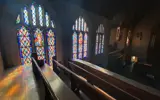The History of Architectural Glass: From Ancient Times to Modern Façades

Glass is one of the most remarkable materials in architectural history. From small decorative items in ancient civilisations to the expansive glazed façades of today’s skyscrapers, the journey of glass in building design is a fascinating story of innovation, technology, and transformation. Understanding this evolution helps us appreciate just how far we have come and why modern glass façades are both an aesthetic and technical achievement.
Ancient Origins: The Beginnings of Glassmaking
The earliest use of glass dates back over 4,000 years. Civilisations in Mesopotamia and Egypt were among the first to experiment with glass, though it was initially used for decorative items like beads and containers rather than for architecture. Glass was expensive and difficult to produce, making it a luxury reserved for the elite.
It was not until the Roman Empire that glass began to be used in buildings. The Romans developed early forms of window glass by casting molten glass into flat sheets or spinning it into discs. However, this glass was far from transparent. It let light through but was cloudy and uneven, limiting its use and appeal.
Medieval Glass and the Rise of Stained Windows
During the Middle Ages, the use of glass in architecture took on a new and spiritual role. Churches and cathedrals across Europe began to feature stained glass windows that were both decorative and symbolic. These windows told biblical stories and added colour and light to otherwise dark interiors.
The production of stained glass became an art form. Although the technology remained relatively simple, skilled craftsmen created intricate designs that reflected the values and beliefs of the time. Glass remained costly, so it was rarely used outside religious or royal buildings.
Renaissance to Industrial Revolution: A Turning Point
The 17th and 18th centuries marked a shift in how glass was made and used. New production techniques, including the cylinder and crown glass methods, allowed for clearer and larger panes. This meant glass was no longer limited to the wealthy. Gradually, it found its way into homes, shops, and public buildings.
The Industrial Revolution brought major changes. Mass production made glass cheaper and more accessible. Innovations in both manufacturing and building design led to the first greenhouses, train stations, and shopping arcades with large glazed roofs. Architects began to see glass not just as a way to let in light, but as a key material in structural design.
Modernism and the Rise of the Glass Façade
The early 20th century introduced a new way of thinking about architecture. Influential designers such as Le Corbusier, Walter Gropius, and Mies van der Rohe saw glass as a symbol of modernity. They embraced minimalist design, clean lines, and open spaces, using large glass panels to break down the barriers between inside and outside.
This era also saw the rise of the skyscraper. Steel and reinforced concrete made it possible to support taller buildings, and the invention of the curtain wall allowed glass to become the skin of these new structures. The result was a revolution in urban architecture. Buildings became lighter, more open, and more connected to their surroundings.
The Technical Revolution: Performance and Possibility
Today, architectural glass does far more than look impressive. Thanks to rapid advances in technology, glass now plays a vital role in building performance. Modern façades feature double or triple glazing, thermal coatings, and laminated or toughened safety glass. Some systems are even designed to change transparency or reflectivity depending on the time of day or building use.
High-performance glazing improves energy efficiency by reducing heat loss and solar gain. It also helps control acoustics, enhances security, and allows for creative design solutions. Architects are now using curved glass, fritted glass, and switchable panels to create façades that are both functional and beautiful.
Our Role in the Evolution
At Glass Aftercare, we work with these modern façades every day. Our job is to maintain and protect the glass that defines today’s architecture. While the techniques have evolved dramatically, the importance of caring for glass remains as vital as ever. Damage, wear, and environmental exposure can all compromise the performance of a façade, which is why regular inspection and expert maintenance are essential.
From humble beginnings in ancient workshops to cutting-edge towers with intelligent façades, the story of architectural glass is a powerful reminder of what is possible through human creativity and engineering. As this story continues, we are proud to be part of it, keeping modern façades looking their best and performing at their peak.

About the author
Glass Aftercare
Glass Aftercare is the commercial glass maintenance, façade refurbishment and glazing repair specialist. Providing a service you can trust, all across London and the Home Counties.
GLASS AFTERCARE ARE TRUSTED BY








